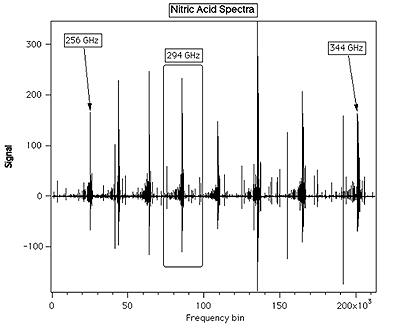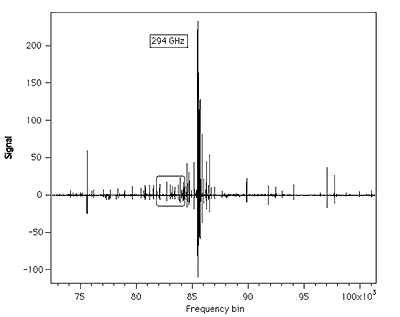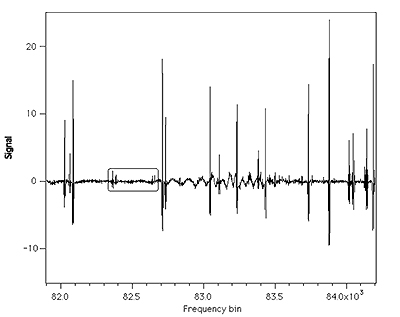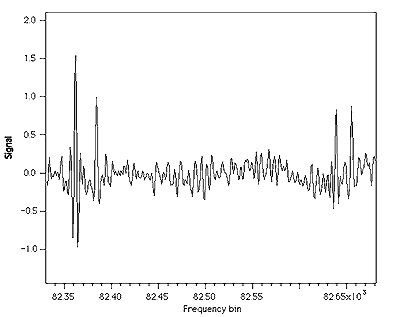Millimeter and Submillimeter Techniques
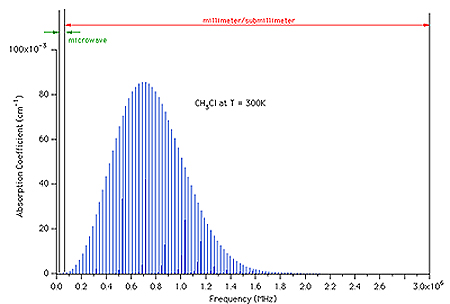 |
Over the years many important applications have been identified for the
millimeter and submillimeter (mm/submm) spectral region. These include studies
of:
- Basic molecular physics including spectroscopy and the study of collisions
- Remote sensing of the interstellar medium and the atmosphere
- Plasmas
- Communications
- High resolution radar and imaging
|
| CH3Cl Spectrum |
|---|
Many of these applications, especially those of interest to the Microwave
Laboratory, exploit the very strong interaction between mm/submm radiation
and the rotational degrees of freedom of small, fundamental molecular species.
The figure shows a typical case, CH3Cl. Here the absorption
coefficient rises as the cube of the frequency (due to increasing photon size,
the Boltzmann factor, and state degeneracy) before reaching a peak and
falling exponentially due to the Boltzmann population).
(Blake, et al.)
(Warner, et al.)
(Bogey, et al.)
Other Realted Sites
A substantial share of all of the scientific studies in the mm/submm
spectral region have been done using the nonlinear harmonic generation and
cooled detector methodology first put forth in our 1970 paper and more
recently extended. (283, 268)
Briefly, our basic spectroscopic system uses klystrons or YIG
oscillator driven TWT's in the region around 50 GHz to drive nonlinear
harmonic generators. The resulting mm/submm energy is radiated
quasi-optically through absorption/emission cells and detected by an InSb
detector operating at 1.5 K or a 0.3 K germanium bolometer. Associated
electronics are used for frequency measurement and signal recovery, providing
in effect a synthesized system for the 100 - 1000 GHz region. Systems of this
type have proven to be reliable, easy to operate, and reasonably inexpensive.
Because of these attributes, a number of similar systems have now been built
at laboratories around the world and have become the standard for a wide range
of molecular studies in this spectral region. The figure shows the YIG
oscillator - TWT broadband version of this basic system.
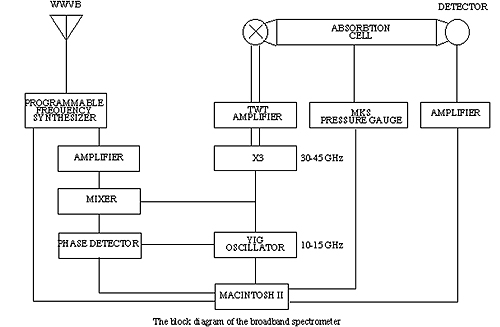 In this system a computer controlled YIG-tuned
oscillator/Traveling Wave Tube combination provides the fundamental microwave
power. The spectral purity and tuning linearity of the YIG oscillator make it
straightforward for the computer to automatically lock the oscillator to a
frequency derived from the synthesizer. Since it is possible for this system
to record a very large number of lines in a short period, we have developed a
number of routines that enable the host computer to automatically locate and
measure lines, subtract baseline, calculate pressure broadening parameters,
etc. For additional implementations:
(Anderson and Ziurys)
(Pickett, et al.)
(Demuyuck)
In this system a computer controlled YIG-tuned
oscillator/Traveling Wave Tube combination provides the fundamental microwave
power. The spectral purity and tuning linearity of the YIG oscillator make it
straightforward for the computer to automatically lock the oscillator to a
frequency derived from the synthesizer. Since it is possible for this system
to record a very large number of lines in a short period, we have developed a
number of routines that enable the host computer to automatically locate and
measure lines, subtract baseline, calculate pressure broadening parameters,
etc. For additional implementations:
(Anderson and Ziurys)
(Pickett, et al.)
(Demuyuck)
Related information:
Claude Woods,
or Lucy Zuirys.
 For a number of years (392) we
have been interested in the Fourier Transform relation between the
pico/femtosecond time scale and the mm/submm spectral region and its
scientific and technological exploitation. Recently, we have developed a
system based on the demodulation of a femtosecond Ti:Sapphire laser pulse
train. (458)
The figure shows the basic layout.
For a number of years (392) we
have been interested in the Fourier Transform relation between the
pico/femtosecond time scale and the mm/submm spectral region and its
scientific and technological exploitation. Recently, we have developed a
system based on the demodulation of a femtosecond Ti:Sapphire laser pulse
train. (458)
The figure shows the basic layout.
The pulse train from the femtosecond laser drives an integrated semiconductor
switch/antenna. The current which flows in the antenna produces mm/submm
radiation whose frequency spectrum is given by the Fourier transform of the
temporal optical pulse train. More specifically, this spectrum consists of a
large number of high spectral purity (~3/108) components, each of
which is an exact multiple of the mode lock frequency. Components of the
mm/submm radiation are selected by passive mm/submm quasioptical techniques for
spectroscopic application. One of the most important features of this system
is that the frequency of the components is easily calibrated by simple
electronic means (the counting of the mode lock frequency near 100
MHz). Additionally, because the mm/submm frequencies are directly
related to the length of the laser cavity rather than the difference between
two optical cavities, the spectral purity of the source is very high, even
without active or passive stabilization schemes.
See also Elliot Brown.
Electron Beams
Backward Wave Oscillatiors
A series of Backward Wave Oscillator Tubes (BWOs) have been developed by the
ISTOK corporation of Fryazino, Russia which span the microwave spectrum from
below 100 GHz to above 1000 GHz. These devices are broadly electrically
tunable and have good noise characteristics. As such they are excellent
spectroscopic sources. They have been used as the basis of a number of
spectroscopic systems. Among the earliest were those developed in Nizhny
Novogorod, Russia at the Institute of Applied Physics and reviewed by
Krupnov and Burenin
(Krupnov and Burenin).
For high resolution spectroscopy, frequency control has ordinarily been
achieved by the use of frequency multiplier chains and phase lock loops
(Krupnov et al.,
Belou et al.).
For frequencies through about 200 GHz, commercial versions of
these sources have becom available from KVARTZ and AMC. An alternative
approach has been developed in which the BWO is locked to a Fabry-Perot
cavity, which is mechanically scanned (Rad III).
We have developed another alternative (FAST Scan Submillimeter Spectroscopy
Technique, FASSST) which takes advantage of the high
spectral purity of the BWO and uses a fast sweep (~ 105
linewidths/sec) to "freeze" instabilites associated with power supply ripples,
thermal drift, etc.
Because ~ 106 points are recorded (in 1 - 10 seconds), it is not
possible to display a spectrum in its entirety here. However, the sequence
of successive blow-ups illustrates the results.
Because of the fast sweep, ~ 106 Hz of detection bandwidth was
used to record the spectrum. The use of a bandwidth typical of high resolution
microwave spectra (1 Hz) would increase the signal to noise ratio by ~ 1000.
Company Data
Relativistic Electron Beams
This section is still under construction. In the mean time you may be
interested in our recent papers
(462, 465). You may also
find these sites informative:
Return to
The Microwave Laboratory
<OSU Physics Department
|The College of Math and Physical
Sciences
|The Ohio State University
>

 In this system a computer controlled YIG-tuned
oscillator/Traveling Wave Tube combination provides the fundamental microwave
power. The spectral purity and tuning linearity of the YIG oscillator make it
straightforward for the computer to automatically lock the oscillator to a
frequency derived from the synthesizer. Since it is possible for this system
to record a very large number of lines in a short period, we have developed a
number of routines that enable the host computer to automatically locate and
measure lines, subtract baseline, calculate pressure broadening parameters,
etc. For additional implementations:
(Anderson and Ziurys)
(Pickett, et al.)
(Demuyuck)
In this system a computer controlled YIG-tuned
oscillator/Traveling Wave Tube combination provides the fundamental microwave
power. The spectral purity and tuning linearity of the YIG oscillator make it
straightforward for the computer to automatically lock the oscillator to a
frequency derived from the synthesizer. Since it is possible for this system
to record a very large number of lines in a short period, we have developed a
number of routines that enable the host computer to automatically locate and
measure lines, subtract baseline, calculate pressure broadening parameters,
etc. For additional implementations:
(Anderson and Ziurys)
(Pickett, et al.)
(Demuyuck)
 For a number of years (392) we
have been interested in the Fourier Transform relation between the
pico/femtosecond time scale and the mm/submm spectral region and its
scientific and technological exploitation. Recently, we have developed a
system based on the demodulation of a femtosecond Ti:Sapphire laser pulse
train. (458)
The figure shows the basic layout.
For a number of years (392) we
have been interested in the Fourier Transform relation between the
pico/femtosecond time scale and the mm/submm spectral region and its
scientific and technological exploitation. Recently, we have developed a
system based on the demodulation of a femtosecond Ti:Sapphire laser pulse
train. (458)
The figure shows the basic layout.
